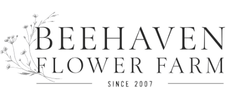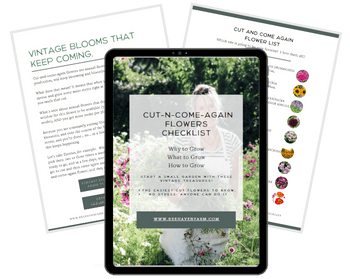
Marketing | 13 Places to Sell Your Cut Flowers
13 Places to Sell Your Cut Flowers (Besides “Just the Farmers Market”)
When I started selling cut flowers, people really weren’t familiar with garden-grown, fresh flowers for sale. I remember when I started my florist route, and a florist said, “You mean you grew these in your garden?” she really didn't want to buy.
Fast forward to now: local flowers are having a moment.
People are excited about them. And the opportunities to sell what you grow are way bigger than you think.
In this post, I want to walk you through where you can sell your flowers and how to think about what you’re offering, so your brain starts spotting opportunities everywhere: in town, on your road, even in your inbox.
Before we get into all the places, let’s get clear on what you’re selling.

First: Know Your Three Core Products
Buckets, Bunches, and Bouquets
Almost everything you’ll sell falls into one of these three categories:
1. Bouquets
This is your mixed bundle of joy.
Multiple flowers + foliages
Styled together
Either:
Wrapped (paper + a little water bag on the bottom), or
Arranged in a vase
Anytime I say “arrangement,” I mean: bouquet in a vase.
2. Bunches
This is one type of flower, all by itself.
Usually 10 stems per bunch (that’s the industry norm)
Think: 10 peonies, 10 sunflowers, 10 stems of a particular flower or foliage. (Foliages can sometimes be sold by weight)
Florists and wholesalers are counting stems for recipes, so consistency matters
You can also do grower’s bunches:
A mix of stem grades (A, B, C, etc.)
Often a little fuller or bushier
Florists love these; they understand that each stem has some variability in size, and they usually get a bit more.
3. Buckets
Think of a bucket as “bulk flowers, ready for someone else to play with.”
Can be all one thing (like a foliage bucket) or a mix
You can think in terms of:
“There are about 3–5+ straight bunches in this bucket,” or
“This bucket has about X stems at $Y per stem”
Buckets are your best friend for DIY customers, restaurants, and events.
Once you understand buckets, bunches, and bouquets, everything else is just:
Who am I selling to, and how do they like to buy?
Let’s walk through the options.

1. Flower Subscriptions (Your Built-In, Recurring Revenue)
Subscriptions are a great model because they give you:
Regular, weekly sales
Predictable harvests
A reason to get those flowers out of the field regularly
You can offer:
Weekly
Bi-weekly
Monthly
And you can deliver:
Wrapped bouquets
Arrangements
Or even buckets, if your customer likes to design their own
A few subscription ideas:
“Summer of Flowers” for individuals. A great Mother’s Day kick-off to your season.
Example: a Mother’s Day gift that runs all summer - buckets, bunches, or bouquets
Business subscriptions
Premium weekly arrangements for higher-end clients
💡 Tip: Build delivery into your pricing (or be very clear if it’s pickup-only). And make sure you have a simple way to remind people: “Your flowers are ready!”
2. Business & Office Flowers (Professional Spaces That Need Pretty)
Think of:
Dentists & Doctors
Chiropractors
Realtors
Accountants
Small boutiques or salons
They often want:
A weekly arrangement for the front desk
Or a bucket of stems for someone on staff who enjoys arranging.
This is a beautiful way to:
Get recurring income
Use what’s blooming that week
Get your flowers in front of a lot of eyeballs
You’re not just selling to the office. You’re quietly marketing to every person who walks through the door.
3. Restaurants & Hotels (Atmosphere Flowers)
If you live near a city or tourist area, restaurants and hotels can be great:
Restaurants might want:
Tiny bud vases on tables
A weekly bucket so staff can place stems around the space
Hotels might want:
A larger entryway arrangement
Regular deliveries of loose flowers for someone on staff to use
These often lean toward simple color palettes and reliable weekly/biweekly delivery.

4. Farm Stand (Your “Anything-Can-Happen” Outlet)
I love a farm stand. (Yes, I have one, and one regret I have is that I did not build it right away!!)
It gives you a place for:
The tall, perfect showstoppers
And the short, quirky, “how am I going to sell you?” stems
Those Veronicas that came up embarrassingly short?
Perfect for little bud vases or small bundles at the farm stand.
At a farm stand you can sell:
Wrapped bouquets
Straight bunches
Buckets
Bud vases
Mixed “surprise me” bundles
People come to a farm stand for the experience as much as the product. Use that to your advantage. Extra eggs to sell? Are your kids making bird houses? Did you crochet all winter?

5. Farmers Markets (Like a Mobile Farm Stand)
Farmers' markets work a lot like a farm stand, but you go to the people instead of them coming to you.
What works well at markets:
Wrapped market bouquets (Mixed wrapped flower bouquets were always my number 1 seller)
Straight bunches (any size bunch you choose… it does not have to be the industry standards)
A few arrangements to show what’s possible and get people to buy your bunches & bouquets
Buckets of one thing (like sunflowers or foliage) if the vibe fits
Your job is to:
Harvest what the field is giving you
Then put your marketing brain to work:
“How do I sell this in a way that feels exciting and valuable?” Buy one get posy for $X. Fund signage: "In the dog house? I can help." "Peonies represent a happy marriage"
Remember:
Most people don’t need 3-foot stems. They need something pretty on their table, that is fresh and will have a long vase life.
6. Pop-Up Stands (Portable Flower Parties)
Pop-ups are basically temporary mini flower shops:
At the end of your driveway
In front of a local business
In town with permission from the city
Partnering with a boutique, coffee shop, or event
You can run them:
Weekly (“Every Friday from 3–6 at X location”)
Every other week
Seasonally (tulip pop-up, peony pop-up, dahlias-only pop-up)
The key with pop-ups is consistency:
If you say you’ll be there, be there.
And if life happens, make sure someone else runs it for you.
People will adjust their schedules to swing by if they know you’re reliable, and you will build a loyal market that way.
7. Wholesale to a Wholesaler (Your Lowest Price, Highest Volume)
Wholesale to a wholesaler is the bottom price tier, but it has a purpose.
You’re selling straight bunches (usually 10 stems)
They flip it to florists
You accept a lower per-stem price in exchange for:
Moving a lot of product quickly
Not having to deal with dozens of smaller customers
This is a great outlet when:
You’ve hit a bloom peak
You just need to move product
Cash flow matters more than max profit per stem
Just know:
They have to mark it up to sell to florists, so your price needs to leave them room to profit, too.
8. Wholesale to Grocery Stores (Still Wholesale, Better Margin)
Grocery stores are also wholesale, but the margins can be better than selling to a traditional wholesaler.
For example:
You might sell them bouquets instead of stems
You negotiate a price where:
The bouquet sells for, say, $20 in the store
You receive $15
That can pencil out to a better per-stem price than strict wholesale
You’re basically renting a “shelf” in a place that already has foot traffic and checkout systems set up. You don't have to build and staff a store and you can push a lot of product.
If you go this route:
Standardize your bouquet sizes
Make sure barcoding/pricing is clear
Keep communication open about what’s in season and available with the produce manager
Be dependable. They will lower their flower order in the summer to accommodate you, so be sure you show up regularly.

9. Selling Direct to Florists (Relationship + Reliability)
Selling to florists is still wholesale, but typically at a higher price than selling to a wholesaler.
Florists care about:
Stem quality and freshness
Consistency Hint: Leave your farm on the same day at the same time every week and stop by the florists in the same order. This way you (roughly) arrive like clockwork.
Standard bunch sizes
Clear communication
A few tips from my own experience:
Don’t show up expecting $3/stem for dahlias and assume they can just triple that.
Remember: they need to mark it up three times to cover their costs.
You can use “grower’s bunches” with mixed stem grades, as long as:
You price them fairly
They feel generous and usable to the florist
Building a good relationship with a florist can give you:
Steady orders with a weekly florist route.
Feedback on what sells
A better understanding of design trends
A place to sell your excess once you know your garden and can communicate "What's coming up". They can plan designs around this on a seasonal basis.

10. Garden-Florist Work: Everyday Flowers
This is where you wear both hats: grower and designer.
Everyday flowers include:
Birthdays
Anniversaries
Get-well bouquets
“Just because” orders
You get to lean into your own style and say: “When you order from me, you’re getting my style of design that will be a one-of-a-kind and unique specialty cut flower arrangement…(my way of doing flowers).”
You don’t have to offer everything:
You can limit color palettes… I would suggest starting with colorful, that is the easiest and guaranteed.
Limit order days
Limit the types of arrangements you offer
You’re allowed to design a business that fits your life and energy.

11. Weddings (From DIY Buckets to Full Service)
Weddings can be:
Highly profitable
Highly demanding
Or a mix of both, depending on how you structure your offers
You have options:
DIY buckets:
Couple picks a color palette, again, I suggest colorful when you are small
You provide buckets of stems
They do their own designing
À la carte:
They choose from a menu (bouquets, boutonnieres, centerpieces)
No custom, from-scratch design planning
Full service:
You design the entire floral plan
You deliver, set up, and sometimes tear down
Here’s the big caution:
Don’t forget to charge for the service side of weddings.
Delivery, setup, and teardown are their own job. Price it like one.

12. Sympathy Flowers (Deeply Meaningful, Quietly Powerful)
Sympathy work includes:
Funerals
Celebration of life services
Memorial gatherings
This work matters. It’s emotional.
I think about sympathy flowers as:
A way to channel care and beauty into a really hard moment and make it beautiful
A powerful use of what we grow
You can decide:
If you want to specialize in this
How much of it fits your capacity
Whether you do full services or simpler pieces
I often consider taking my creative design in this direction. I really like making a celebration of life beautiful and meaningful. They are small events that I enjoy creating, unique and tailored to the season, from what my garden has to offer.

13. Dried Flowers & Off-Season Sales
Just because your fresh season slows down doesn’t mean your flower income has to.
Dried flowers can be:
Bundles
Wreaths
Swags
Dried arrangements
Often, they sell well:
In late winter
Early spring… for me, spring is when I get a surge of orders for my dried flowers.
You’re essentially giving your summer abundance a second life. And it's a great way to sell later what didn’t sell during the summer.
Be intentional during the season and create special harvests to capture what isn’t sold or hang what didn’t sell.
Q&A: Common Questions About Selling
Q: “What if my flowers aren’t tall or ‘perfect’?”
A: If they’re fresh and have good vase life, you can sell them. Short stems? Perfect for bud vases and small posies... many people enjoy this style, and depending on your vase, you can design and sell them. It’s often a marketing and framing problem, not a flower problem.
Q: “Do I have to do all of this?”
A: Absolutely not and I wouldn't recommed it. Pick one or two paths that fit your life right now. You can always add more later.
Remember: If You Do Something, Something Will Happen
You don’t have to have your forever business model mapped out.
Start where you are:
Maybe it’s your kids selling cosmos at the end of the driveway
Maybe it’s one business subscription.
Maybe it’s a tiny farm stand with whatever’s blooming.
As you move, doors open. Conversations happen. Lightbulb moments show up while you’re harvesting.
You learn by doing, not just dreaming.
Want Help Choosing What to Grow and Where to Sell It?
Knowing where to sell your flowers is one piece.
Knowing what to grow, how much, and when to plant it so you have flowers to sell all season long, that’s the real game-changer.
If you’re ready to:
Grow florist-grade flowers
Plan a garden that blooms week after week
And sell what you grow with confidence
Your next step is:
👉 Watch my free training: Cut Flower Foundations and Get Started on The Right Journey


